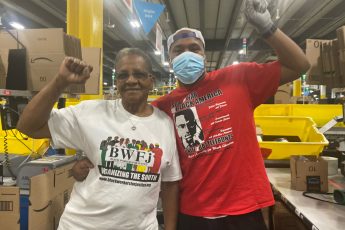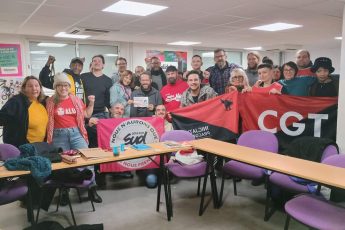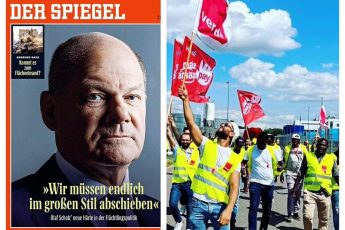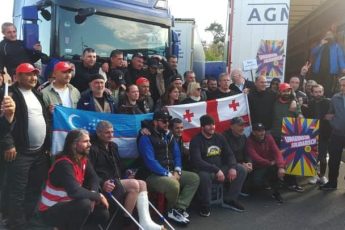
We continue our new website section called “conflict corner” with an article from TIE (Transnationals Information Exchange), which is a global grassroots network of workers active in workplaces and communities. In the text the German section discusses successful experiences of self-organizing in the fashion company H&M, which is “a forerunner in precarious contracts in Germany”. Company strategies to prevent collective struggles are analyzed as well as the limits of the usual unions approach. With the concept of “mentors” it was possible to organize workers in about one third of the 400 H&M stores in Germany, to found works councils, to invent shop floor strategies to improve occupational health and safety, to push back precarious contracts and to become one of the most important unionists during strikes in the national collective bargaining. The works councils developed a transnational worker-to-worker network with garment unions which organize workers who produce for H&M and other retailers. They struggle together along the global value chain for better working and living conditions in the global garment industry.
In Europe and North America, fashion retailers like H&M, GAP or Zara characterize the image of the cities we live in. Their advertising surrounds us and they shape the way we dress and what we think is fashionable. When we enter the stores we see mainly young women who do not only sell clothes but fashion. The interior of the stores, the advertisement and the way we are treated shall make us believe we buy something special and crucial to our identity.
In the trade union movement, organizing workers in retail sector has not been a key issue so far despite the meaning of fashion retail for our lives. All the more as fashion companies like H&M and Zara grow, employ more and more workers all around the globe and at least for the case in Germany succeed in the competition against older retailers which used to be union bastions.
The usual image of those workers is one of a female, precarious workforce which cannot be organized and if so need strong support by union reps and external resources. No matter whether it is in the US, Europe or elsewhere. So far it has been very difficult for unions not only to organize fashion retail workers but also to develop a self-organized union work at the shop floor level which improves working conditions and strengthens the workers in their struggles for a decent life.
The experience of H&M workers in Germany gives an impressive example of how union work in the retail sector might look like. Over the last ten years, they organized workers in about one third of the 400 H&M stores in Germany, founded works councils, invented shop floor strategies to improve OHS, pushed back precarious contracts and became one of the most important unionists during strikes in the national collective bargaining. They were able to shift the power relations at the company level in favor of the workers and built own capacities to influence conditions at their workplace and beyond. They developed an international worker-to-worker network with garment unions which organize workers who produce for H&M and other retailers. They struggle together along the global value chain for better working and living conditions in the global garment industry.
Sad to say, that even in Germany the H&M experience has not been recognized as a winning strategy until recently by their union ver.di. In Germany, the discussion about the renewal of the trade union movement is focused on institutions and projects lead by paid organizers. The H&M experience shows that it is worth to take a closer look at the rank-and-file.
Coercion and Community for retail workers
What does it make so difficult for retail workers to organize? There are several aspects which put challenges to those who want to organize in retail.
The competition between the companies is very high. They compete against each other mainly over labor costs. The consequences are highly flexible contracts, low wages, increased workload and pressure, work restructuring and a decreased number of workers on the shop floor. This has enormous impact on the worker’s health and family life. H&M is a forerunner in precarious contracts in Germany: the workers often neither know in advance when they work during the week nor how many hours they work and therefore do not know how much money they earn in a month. If you want to make ends meet, a second job is often vital but it is difficult to accept one because retail workers only know week by week when they will work.
Now one could argue this opens a door for unions: if there is trouble there will be resistance. If not, workers are either not willing or not capable of standing up for themselves – that is the usual argument. But retailers usually combine these conditions with repression of any efforts to organize and with the notion of community within the company. The retailers create an atmosphere in which hierarchies are allegedly low, individual promotions and gratifications are possible and problems can be solved on the individual level. The company promotes a culture which claims the workers and the company have the same interests. They create the image of a family which struggles together for the company’s success and they spend lots of money and resources to maintain it (e.g. H&M teaches every new worker about the history and the ideals of the founder of the company, Zara holds meetings in the morning to start the work day together and talk about todays’ goals). The workers should accept the company’s goals as their own and everything what might challenge the achievement of the goals is dangerous.
Sadly, this management style is not only typical for H&M or Zara but very common among retailers and beyond. It is nothing external to the workers, too because this idea is linked to real experiences at the shop floor: workers can talk about problems but only if they perceive them as their individual problems, meetings create community, workers experience recognition if they are a successful salesperson or they can get a promotion if they are the store manager’s favorite. This ties the workers to the company and makes collective struggles for better working conditions supposedly less necessary.
On top of that, it is very difficult to think about problems as collective problems. The company culture offers a strong and influential explanation of the workers’ experience at the shop floor. If workers think the pressure they face, the financial difficulties they have or the mental problems they suffer from are the consequence of their misbehavior or their false attitude, it will be very difficult to even thinking about a works council or a union as a realistic solution let alone to act collectively.
The consequences are harsh: workers who still want to organize, to form a works council or to address problems collectively are treated as runner-downs – not only by the executives but also by their fellow workers. This makes repression easier because there are less people who will stand up for those who want to organize. This affects also organizing drives from the outside: unions are usually seen as something external and unnecessary because the family can deal with everything. Even if they are successful, they are often not able to develop an alternative to the company culture and unionists and works councils more and more become transmission belts for the company’s imperatives – unless an alternative to that family culture is developed.
From workers to mentors to organizers
In retrospect, the workers found a solution as simple as effective but it was a long road from about seven stores with union activists and works councils to about 140 organized stores. At the beginning stood a collective process of those who were interested in union work and who wanted to form works councils to become stronger and change the working conditions at H&M. In this process, they talked about their experiences at the work place, the pressure and repression they face and the violations of their dignity they suffer from. These experiences have no space within the company but are expelled systematically. They do not fit in the company’s family ideology which only encourages those attitudes which can be exploited. Once the workers understood that they share common problems which are caused by H&M, this offered the possibility to develop solutions and break the isolation of the few works council activists. Through the understanding of what H&M does to them, they gained confidence in their own strength. Problems and conflicts were not seen as individual faults anymore but as the result of work organization and H&M’s policy and therefore could be changed.
The few organized H&M workers started to visit stores which did not have a works councils or unionized workers. They did this in their free time or used a loophole in the German law on codetermination which allowed them to go there as part of the works councils activities. They supported the workers on the shop floor or in the warehouse – as H&M workers the know how to be handy – and talked with the workers about problems, their experience at the shop floor and what might be possible solutions. The problems in all the shops are similar: lack of personnel, fear of losing your job, flexible working hours, precarious contracts, low wages etc. Sooner or later they talked about forming a works council and shared their experience what workers can achieve collectively. They presented arguments to the workers and supported them to convince their co-workers. Sometimes this needed several meetings – sometimes also outside the stores in their free time – but sometimes workers were convinced easily.
Referring to H&M’s policies to integrate new workers in the family, the activists called themselves mentors. At first, they focused on founding works councils which is usually the first step to organize in Germany. Together with the interested workers from the store, they did this often secretly because H&M tries to get rid of workers who want to form a works council – as other companies do as well. Only when the election is announced, candidates have some security not to get fired. But: regarding to the company culture this alone is worth nothing. What can a works council do or a union which is opposed by the majority of the workers?
The works councils and mentors understood their job as to create spaces in which they discuss with their fellow workers and which they use to share and to think about their experiences at work. Workers assemblies are a good tool for that. At the same time the mentors made their own interest clear: strong works councils and unionized workers in other stores improve their negotiation power in the company as well. Therefore it was not only about forming works councils but about building militant workers who are capable of changing the power relations at the shop floor. The mentors accompany the new-fledged activists to help them build a strong works council and union on the ground. They provide tools how to solve problems and how to organize their own work and involve them in the discussion about union and works council strategies within H&M.
The key issue is to provoke discussions and to talk about aspects of the work experience which usually do not have any space at the work place. The mentors link the experiences of precarity and bad working conditions to the company’s policy and to contradictory interests of workers and the management. But they do not only develop a different understanding of the situation at H&M together but also offer possible courses of action. Every strategy they implement is considered whether it strengthens the workers and whether it builds capacities among them to interfere with the working conditions. This is no easy task because it needs self-conscious mentors, works councils and unionists who know how to talk to their fellow workers, who are self-aware of the problems and conflicts at the shop floor and who are willing to discuss and criticize their co-workers point of view. Thereby they create capacities for themselves and for other workers to act, strategize and think differently.
It was important to make clear that things at the work place can be changed and that problems are collective problems which also the mentors have. Mentors were and still are very resourceful in doing this: when they wanted to address the issue of OHS, they asked the workers about their work process. Due to the lack of personnel and time, retail workers usually carry lots of clothes through the store, often more than 20lbs on one arm. The mentors filled a beverage crate with the same weight of water and asked the workers to carry this with one arm. Nobody wanted to and the discussion how they can improve their situation started.
The result of this ongoing process is that the mentors were able to force back the company family and to create a community among the workers in which conflicts, needs and interests can be articulated. Differences and commonalities can be found. Based on this, a solidary WE is developed. The problems and conflicts are understood differently now: instead of blaming your fellow worker when she is ill and you have to pick up the slack workers criticize H&M for not hiring enough workers for the shop floor. This is the condition for further steps like strike actions, campaigns, the cooperation with unionists from other retailers and with garment unions who organize workers of H&M suppliers in the Global South.
All in all, the mentors act as member-organizers. They developed their strategy out of their everyday experience without the help of their union. It is based on a rank-and-file initiative which was developed through common reflection, discussion and planning and is based on the idea to build workers capacities on the shop floor.
Learning from the H&M experience
Only on the first look, the strategy of the H&M workers is linked to the German system of codetermination. They use the legal possibilities of the German industrial relations as a tool but what they actually do goes far beyond. They found union work as a space for what is expelled from the work experience and from the shop floor by the company. Based on the experience of the conflicts and problems which workers face, the H&M mentors promote a different understanding of what happens at H&M among the workers and create a solidary unity. Problems are understood as a result of contradictory interests and needs of workers and the company. In doing that they strengthen themselves and other workers because they build capacities to affect the working conditions. A different understanding of what a union is and should be is linked to it. A union is not only about campaigns and much less about the institution but has to become a collective space where workers can discuss, learn from each other, strategize and develop the necessary capacities to change themselves, their workplace and in the end the society.
This is crucial for any union renewal because changing forms of work and changing habits of everyday life have destroyed the old ties on which union works used to rely to. Not only did they erode but the companies themselves put bonds at their place with influence how we conceive our experiences at work. Unless unions are not able to destroy these company bonds, unions and collective struggles will continue to play a minor role in the life of workers because problems are perceived individually and the only realistic solution is increased competition between the workers and the self-commitment to the company’s success. This makes it not only much easier for the companies to repress organizing drives but also unless unions develop an alternative to the company culture on an everyday basis at the level of the shop floor, even successful organizing drives will not lead to organized and strong work rank-and-file activists but to unions which see their role in promoting the company’s success. Even Worse: this makes it impossible to even talk and think about overcoming the real constraints capitalism puts on the workers because they accept these constraints as their own goal.
It is easy to interpret the H&M mentors as a revival of the shop stewards movement of the 60’s and 70’s. But this would lead to a misinterpretation. The old shop stewards emerged out of strong union structures at the shop floor level and were linked to them. These union structures were often satisfied with securing higher wages and with reducing working hours and were challenged by the shop stewards who wanted not only better working conditions respectively a higher compensation for their hard work but also more democratic union, a less alienating work organization and often had a broader view on union work in general which should contribute to the changing of society.
The experience of the mentors differs from the old shop stewards movement: their new approach makes union struggles possible in sectors which have not been organized so far and they found a solution to new forms of work organization and control mechanisms at the shop floor level. The mentors are up to invent a radical new form of unionism at the local, national and international level which is the condition for any renewed union movement after all. In doing this, they lay the foundation for any further struggles. Even if they do not seem to be as political as the old shop stewards, in times in which unions still struggle for their renewal the H&M experience cannot be valued high enough.





